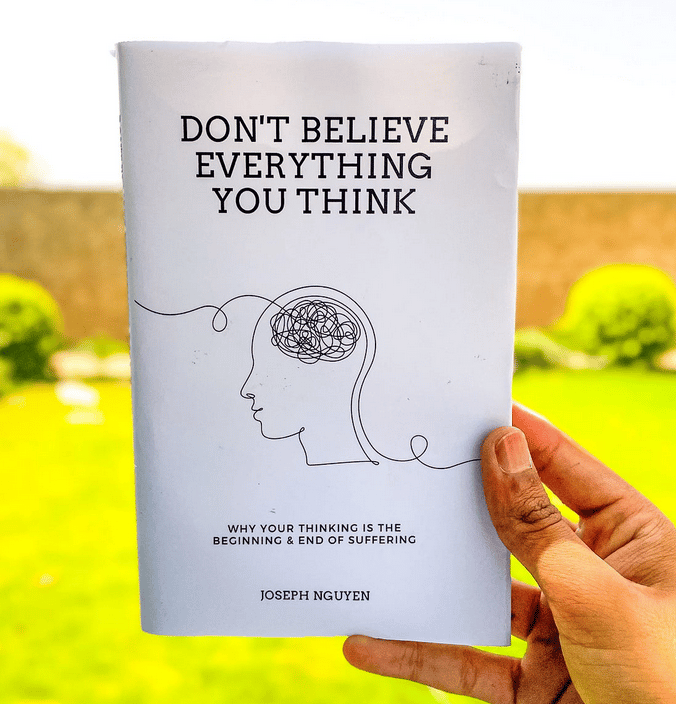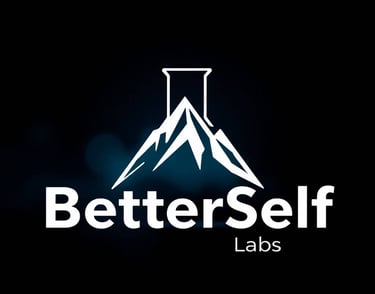Don’t Believe Everything You Think — A Skeptic’s Guide to Loosening Your Mind’s Grip
Verdict: Read for clear reframes and low-friction practices; skip if you want data-dense therapy manuals or step-by-step clinical plans.
BOOKS
9/20/20255 min read


The Big Idea
This book argues you are not your thoughts. Thoughts arise, grab attention, and claim authority; believing them by default breeds anxiety, shame, and paralysis. The fix is cognitive distance: see thoughts as weather, not law. From that stance, you can act on values instead of moods. It solves everyday overthinking and reactivity; it’s lighter on diagnostics, edge cases, and evidence grading.
What’s New Here (and Why It Matters)
The novelty is packaging. Nguyen distills a mix of mindfulness, cognitive therapy, and non-dual language into short, digestible chapters with practical nudges. You get everyday phrasing (“don’t buy every thought”) instead of clinical jargon (“cognitive defusion”). If comparators were provided, I’d map them; Not provided. The contribution: a gentle on-ramp for readers who bounce off therapy textbooks yet need help today.
Core Arguments / Plot Architecture (spoiler-safe)
Structure: Short chapters that cycle through (1) thoughts aren’t facts, (2) identity is fluid, (3) suffering is fueled by resistance, (4) let go and return to presence, (5) act from values.
Key claims (nonfiction):
Attention is trainable; awareness precedes choice.
Belief is optional—thoughts can be noticed without obeying.
Acceptance reduces secondary suffering created by fighting feelings.
Tiny, present-focused actions restore agency.
Evidence style: Anecdotes, reflections, common-sense examples; minimal datasets. Where links to psychology exist (e.g., CBT/ACT ideas), they’re implied more than cited.
Deep Dive
Frameworks & Models (plain names, real-life use)
Notice–Name–Normalize:
Use: When a spike hits, say: “Noticing anxiety… Naming it ‘catastrophizing’… Normalizing: minds do this.” This shrinks the thought’s authority and reduces urgency.
Thoughts → Feelings → Urges (the loop):
Use: Write one recent spiral. Identify the thought (“I’ll blow the presentation”), the sensation (tight chest), the urge (avoid). Replace belief with behavior: rehearse one slide once.
Observer Mode (defusion):
Use: Prefix with “I’m having the thought that…”. Repeat slowly. The distance makes the claim testable, not absolute.
Acceptance + Micro-Action:
Use: Permit the feeling (no fixing for 90 seconds). Pick one valued step you would take if you already felt calm. Do it while feeling not-calm.
Values Compass:
Use: List 3 values (e.g., honesty, kindness, competence). When stuck, choose the action that serves one value in the next 10 minutes.
These are pragmatic interpretations consistent with the book’s themes; not formalized “laws” in the text.
Evidence Check
Strong: The practices align with well-known cognitive-behavioral principles—defusion, exposure to internal states, values-based action. Low risk, high accessibility.
Weak: Sparse citations; mechanisms are argued, not rigorously tested here. Complex conditions (e.g., PTSD, OCD) need more than noticing and letting go. Risk of survivorship bias in examples that resolve neatly.
Assumptions Under the Hood
You can spare micro-pauses in real time.
Your environment won’t punish slower, more deliberate responding.
Symptoms are mild to moderate; safety isn’t at stake.
You’re willing to try behavior first, not wait to “feel ready.”
Practical Takeaways
1-Minute Intercept: 15-second breath + “having the thought that…” + one micro-action aligned to a value.
Worry Window: Defer ruminations to a 10-minute slot at 5 pm. If a worry arrives early, park it on paper; revisit only in the window.
Catastrophe Audit: For one fear, list the base case, best case, worst case, and next step if worst case; do the next step now.
Body First: When anxiety spikes, change physiology (long exhales, slow walk, cold splash) before you reason.
Trigger Map: Track your top three thought triggers (time, place, person). Pre-decide a response script for each.
Values Timer: Set a 10-minute timer; do one action that expresses a value (send the draft, apologize, tidy one shelf).
Media Diet: Reduce catastrophizing cues (doomscrolling) for 7 days; compare mood logs.
Micro-Playbook (print this)
Write your three values.
Learn the sentence: “I’m having the thought that…”
Pick one trigger and a response script.
Schedule a daily 10-minute worry window.
Log one micro-action you took despite discomfort.
Contrarian Note
“Thoughts aren’t real” can be over-applied. Sometimes thoughts are accurate risk signals (financial exposure, health symptoms, unsafe relationships). Blindly “letting go” can become avoidance by another name. The fix: after defusion, run a fact check and, when warranted, take protective action. Skepticism should cut both ways—toward anxiety and toward feel-good dismissal.
Blind Spots & Risks
Clinical complexity: The book underplays cases that require therapy, medication, or structured exposure.
Structural stressors: Some suffering is situational (debt, discrimination, unsafe work). Mindset tools help, but they don’t replace material changes.
Spiritual bypassing risk: “Let go” can be misused to ignore boundaries or accountability.
Cultural framing: Emphasis on individual agency may not fit collectivist contexts or high-constraint jobs.
Who Should Read This (and Who Shouldn’t)
Read if:
You overthink, ruminate, or react quickly and want simple language + small drills.
You’ve tried heavy productivity systems and want mindset basics first.
You prefer practice over theory.
Skip if:
You want dense references, worksheets, and diagnostic depth.
You’re managing severe symptoms without professional support.
You dislike reflective, parable-style self-help.
How to Read It
Pacing: Two or three sittings; apply one tool per chapter.
Skim vs. slow down: Skim anecdotes; slow down on the exercises and reframes.
Format: Audio for first pass; print/ebook for margin notes and trigger maps.
Pairing: If you want structure, pair with a CBT/ACT workbook.
Scorecard (1–10)
Originality: 6 — Familiar ideas, refreshingly plain packaging.
Rigor / Craft: 5 — Coherent and humane; light on evidence grading.
Clarity: 9 — Clean metaphors; low jargon.
Usefulness: 8 — High for day-to-day overthinking.
Re-read Value: 7 — Worth revisiting during anxious seasons.
If You Liked This, Try…
The Happiness Trap (Russ Harris): ACT made practical—defusion, values, and committed action.
Feeling Good (David D. Burns): Classic CBT tools for challenging distorted thoughts.
Unf*ck Your Brain (Bishop): Candid, science-aware drills for anxiety and trauma-adjacent patterns.
The Untethered Soul (Michael A. Singer): Spiritual angle on watching thoughts pass—use with skepticism.
Think Again (Adam Grant): Trains intellectual humility and re-thinking as a habit.
FAQ
Is it evidence-based?
Concepts line up with CBT/ACT (defusion, acceptance, values), but the book itself is light on citations. Treat it as a practice primer.
Will this replace therapy?
No. It’s a self-help complement. If symptoms are severe or persistent, seek professional care.
Can teens use it?
Likely yes—language is simple. Pair with an adult or counselor for tough topics.
How fast will I notice changes?
Often within a week if you practice daily (worry window, defusion sentence, micro-actions). Skill grows with reps.
Is it religious or secular?
Mostly secular, with occasional spiritual flavor. You can apply the drills without any belief system.
Final Verdict
This is a clean starter kit for stepping out of your head and back into your life. The claims are sensible, the tools are small, and the tone is humane. It won’t satisfy readers wanting randomized trials or tailored clinical plans—but if you’re drowning in thoughts and need something you can do between meetings, it earns a buy. Use it to build the meta-skill that scales: notice, name, normalize—then act on values.




